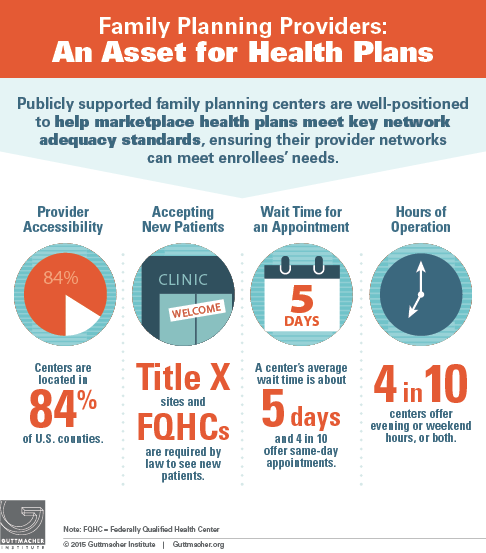Securing provider networks capable of meeting the health care needs of enrollees is a crucial step in translating coverage provided under the Affordable Care Act (ACA) into accessible health services. A new analysis in the Guttmacher Policy Review argues that developing more robust standards of network adequacy is vital to fulfilling the health care needs of all marketplace plan enrollees, and that publicly supported family planning centers are well-positioned to help plans meet many of these standards.
The ACA requires that marketplace plans provide enrollees with reasonable access to care by maintaining a network that is sufficient in the number and type of providers it includes. As part of this network adequacy requirement, plans must include safety-net providers—referred to as essential community providers (ECPs)—that serve predominantly low-income, medically underserved communities. The requirement is intended to ensure that these providers and the people they serve, the very people who are meant to benefit most from the ACA’s coverage expansions, do not get left behind.
"Family planning centers are key access points for many people the ACA connects to care," says Kinsey Hasstedt, lead author of the new analysis. "Because of their sheer numbers, vast geographic distribution and long track record of making high-quality services available to millions of people, publicly supported family planning centers are especially well-placed to provide enrollees with the care they need. In addition, it benefits health plans to include these providers in their networks."

While the ACA has established a broad standard, state policymakers are largely responsible for defining and measuring the specifics of what makes a network "adequate." As a result, network adequacy standards—such as geographic accessibility, number of providers accepting new patients, wait times for appointments, and flexible hours of operation—vary from state to state. Guttmacher’s new analysis reviews and summarizes these standards in detailed maps and tables, concluding that across every state, publicly supported family planning centers are well-situated to aid plans in meeting such requirements.
Federal and state policymakers have the power to establish more robust network adequacy standards. Guttmacher’s new analysis argues that the Department of Health and Human Services should further define the currently vague federal standards, in part by raising the minimum proportion of ECPs with which a plan must contract in its service areas. States, in turn, should strengthen plans’ provider networks by going beyond federal minimums and strictly enforcing their standards.
Lastly, family planning centers themselves need to be assertive about why plans should contract with them. This starts with understanding network adequacy requirements in their states and obtaining and effectively using relevant data. These providers have a strong case to make: They are located in more than eight in 10 U.S. counties and already serve 44% of poor women nationwide who obtain contraceptive care and 34% of women between 100% and 250% of the federal poverty line.
"Millions of individuals rely on health coverage purchased through the ACA’s marketplaces to access health care, including sexual and reproductive health services," says Hasstedt. "But this coverage means nothing if people cannot actually obtain the care they need. State and federal policymakers have a responsibility to solidify the guarantees of the ACA by requiring insurance plans to include sufficient numbers of family planning centers and other safety-net providers in their networks."
Read the full article: "Marketplace Plans’ Provider Networks Are Just Not Adequate Without Family Planning Centers," by Kinsey Hasstedt and Andrea Rowan.
Please refer to the article for detailed maps and tables on state-specific standards for network adequacy, and for contracting with essential community providers.